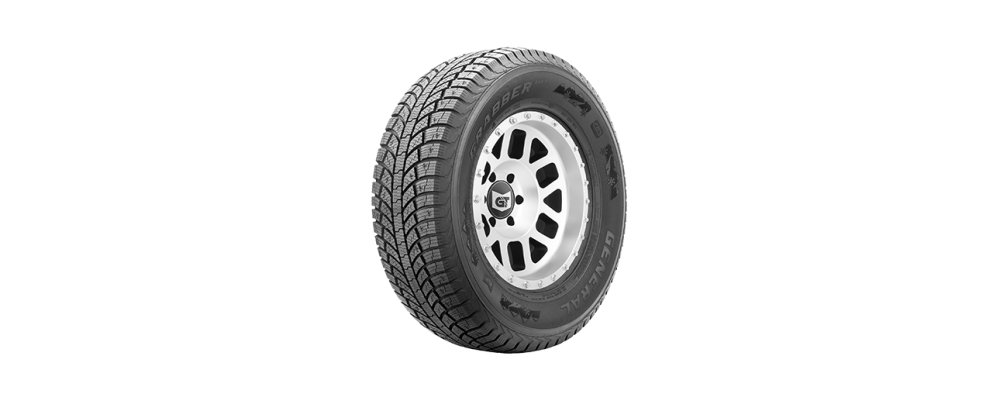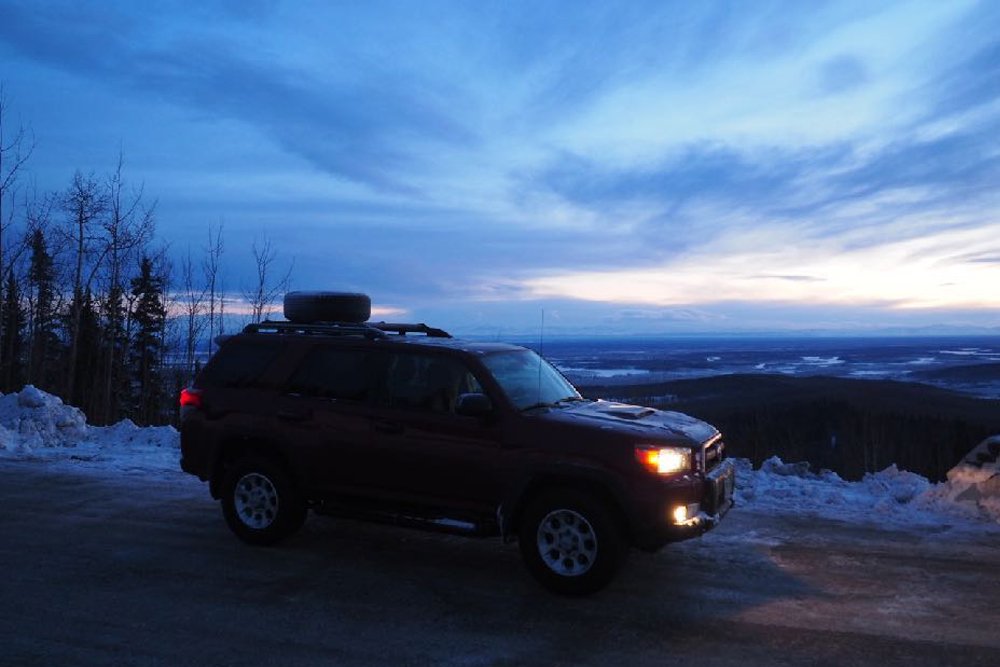
The 5th Gen 4Runner is one of the most capable off-the-lot 4x4s available today—so why would it need a winter tire?
I will begin with the admission that this is my first foray into the world of winter tires.
In the past, I chose all-terrain tires such as the BFGoodrich KO2 for all conditions in all seasons. As a recent transplant to the road system of interior Alaska, however, I must also admit to being a convert to the winter tire school of thought for driving in the coldest, darkest months of the year.
Table Of Contents
Why I Bought Winter Tires
The first addition made to my recently purchased 2013 Trail Edition 4Runner was a set of KO2s in the stock size of 265/70/17.
Past experience with these tires on a Jeep Liberty that I kept in the Anchorage area informed this purchase. Based on that experience and research, I believed that these tires would do an excellent job on the winter roads in the Fairbanks area. They proved to be adequate in this regard.
The first chink in the armor did not take long to appear.
On the AlCan between Tetlin Junction and Whitehorse last October, I ran into an early winter storm. Snow depth on the road ranged from 1-3 feet in unplowed sections of the road. In 4WD at moderate speed, I made it through without incident, though the 4Runner exhibited a constant tendency to wobble at the rear wheels.
Not far outside of Tetlin, the driver of a Kia sedan equipped with snow tires passed me at highway speed. He kept this up until hitting a drift at the vehicle’s hood line, at which point he turned around and headed back the other way. The lesson I took from this, unless ground clearance is an issue, winter tires can provide better traction than 4WD or AWD on non-winter tires.
Is the KO2 Deserving of a 3pmsf Rating?

In town, I found the KO2s to be just good enough for most day to day driving, although 4wd proved to be a necessity at nearly every stoplight to keep the rear of the vehicle from trying to pass the front.
The tires struggled to gain traction under modest acceleration on the icy surfaces common at intersections. While I disliked the wear and tear and reduced gas mileage from using 4WD on paved roads, I figured I could live with it as opposed to buying new tires just a few weeks after buying the KO2s.
A couple of weeks later, en route to Anchorage on the Parks Highway, I ran into deep snow mixed with ice in the early morning hours.
Everything was fine until I crossed a bridge into the town of Healy. At low speed and in 4WD, the KO2s lost their grip on an ice patch, and the 4Runner spun into the oncoming lane, mercifully avoiding oncoming traffic and halting prior to the ditch on the opposite side of the road.
After this incident, I began to look seriously at winter tire options.
How Winter Tires Work

A lot of science and engineering goes into tire design, much of which I must admit I do not fully understand. According to my research, the key features shared by most winter tires are a tread design with close voids, generous siping along the tread blocks, and a softer-than-normal compound used in construction. The smaller voids grip and hold snow, providing surface traction as it contacts snow and ice on the road’s surface. The siping and soft compound also provide additional grip in winter road conditions.
In contrast, heavy-duty all-terrain tires like the KO2 are made of harder compounds to resist off-road damage.
They will wear longer and provide traction on a wider variety of surfaces than winter tires, but cannot match the traction of winter tires in icy conditions.
Most snow-rated tires, like the KO2, will be branded with the three-peak mountain snowflake (3PMSF) symbol, indicating they meet the industry’s severe snow service requirements. But just because they are branded as such doesn’t mean they can really hold up under extreme snow and ice in Alaska.
You can read more details about buying tires in our tire buying guide.
Why I chose the General Grabber Arctic

As I previously mentioned, this would be my first set of winter tires.
I needed to do some research, so I asked around and read a lot of forum posts and a tire-buying guide on Trail4R. Most advice pointed to the Bridgestone Blizzak or Nokian Haakapaleitta, the two established kings of the winter tire world, so I looked into those options first.
The Nokians were beyond the reach of my rather limited budget, while I would have been placed on a waiting list to get Blizzaks in the 265/70/17 size. The estimated wait time was three weeks.
I then looked at other well-reviewed options from Cooper and Toyo. I almost pulled the trigger on a set of Toyo Observe tires at a price just above my comfort level when I received a promotional buy-three, get-one-free tire offer from Toyota.
This provided a great way to get the winter tires I needed at a price point within my budget. One problem–the promotion limited choices to the General Grabber Arctic, the Firestone Winterforce 2, and the Michelin X-Ice.
The Michelin was still on the high side of my budget, while the other two were virtually identical in cost at a much lower price point (roughly half of the quoted price for the Nokians).
The Grabber, however, offered deeper tread and had more favorable feedback than the Firestone offering. Within a week, I had a set of General Grabber Arctics installed on my 4Runner.
Check prices on these winter tires:
General Grabber Arctic Features
The Arctic wears the four mountain peaks/dual snowflake logo, indicating that it meets the industry standard for severe winter weather use. Other prominent features include (from General Tire’s website):
- Wear-Resistant Design: Made from Duragen, a “robust, cut- and chip-resistant compound that maintains its flexibility in freezing temperatures.”
- Interlocking Siping Pattern: “Reduces squirm and block deformation” and offers “exceptional grip in snow, ice, and wet conditions.”
- Symmetric Tread Design: “Improve handling and braking in all conditions.”
- Studdable: The Arctic comes with pinholes for adding 11mm studs for traction on icy surfaces.
- Made in the USA
Initial Impressions

I must admit to feeling a bit chagrined as I backed out of my parking spot at the dealership with my brand new winter tires struggling to gain traction on the hard-packed snow. I also disliked the minivan tire profile, which was reminiscent of the stock Dunlop GrandTreks, in contrast to the blocky, macho KO2s.
However, the Arctics found some bite, and I made it home without incident—and without needing 4WD.
In the days that followed, I grew more impressed with the Arctic’s composure in various road conditions. They go about their job in a quiet, drama-free way that has definitely helped my confidence with winter driving.
Testing Conditions
Most of the miles accrued during the test period occurred on my daily commute. This is a roughly 25-mile round trip of suburban roads and highway driving, with posted speed limits of 40-55 mph. There are several notable curves and elevation changes in the route.
The test period also includes multiple round-trips between Fairbanks and Anchorage. This roughly 345-mile stretch includes multiple mountain passes and a wide variety in the level of winter road maintenance.
Weather conditions predictably varied from clear to modest to severe to why-on-earth-am-I-driving-in-this.
Where the Arctics Struggle

The General Grabber Arctics consistently struggle on ice-glazed hard-packed snow, the type typically found at intersections and turn lanes.
Much like the KO2s, the Arctics flail a bit under modest acceleration. This is perhaps exacerbated by the dead zone at the top of the 4Runner’s gas pedal. Typically, this causes the traction control to kick in. Using 4WD in these situations allows for a smoother, more drama-free driving experience.
Adding studs would likely also help in this scenario, and they are a studdable tire when that time comes.
Long-term positives

I have put roughly 3,500 miles on my set of Arctics, and they have consistently been reliable in foul weather conditions. If traction is lost, recovery has been much quicker and more controllable than with the previous KO2s.
Under most winter driving conditions, they have provided quiet, confident traction at various speeds. Braking, even under duress, has been consistently poised and controlled.
Perhaps the most significant endorsement I can give them is that I have rarely needed 4WD on the road since I bought them. The tires have thus far exhibited minimal, even tread wear.
Are they for you?
If you want improved winter traction at a favorable price, the General Grabber Arctic may be a good fit. Bear in mind, though, that it is not an all-terrain tire and is unsuitable for extended or extreme off-road use.

Hi Dan! I’ve lived in Quebec all my life and I’ve always said-the cheapest winter tire will almost always outperform the best all season/AT tire. Studded Nokians are the ultimate winter tire.